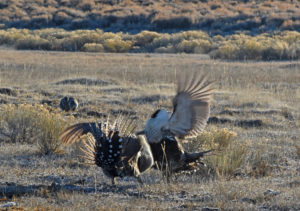Online Messenger #284
(view with pictures, as displayed in email)
Western Watersheds Project released a report critiquing the analysis of livestock grazing in the fifteen plans that are supposed to address impacts to Greater sage-grouse habitat on 60 million acres of public lands. Though the Bureau of Land Management and Forest Service plans all vary in the details, none of them adopt adequate regulatory mechanisms to truly protect the sage-grouse and prevent the need for its listing under the Endangered Species Act.
Livestock grazing is the most pervasive threat to the species across its range and is largely responsible for the peril of extinction the bird is facing. Scientists, judges, and advocates have been telling the Bureau of Land Management and Forest Service that they need to adopt specific measures of protection if they are going to save the species. The agencies have ignored this advice, leaving the plans vulnerable to future challenges and insufficient to thwart ESA protection.
Domestic livestock grazing imperils sage-grouse through trampling and crushing nests, removing key forage vegetation that the birds rely on for food and hiding cover, entangling and trapping birds in pasture fencing, and altering plant communities by spreading non-native and invasive vegetation that increases the flammability of the sagebrush communities. The agencies’ draft plans largely didn’t contain any specific or quantifiable measures that would prevent or reduce livestock-induced degradation.
WWP submitted comments on all the plans and pointed out the inadequacies of the implementation schemes. We can only hope that the remaining plans will be finalized with better protection for the species.
The report was distributed to Bureau of Land Management, Forest Service, and U.S. Fish and Wildlife Service officials and is available for download here.






